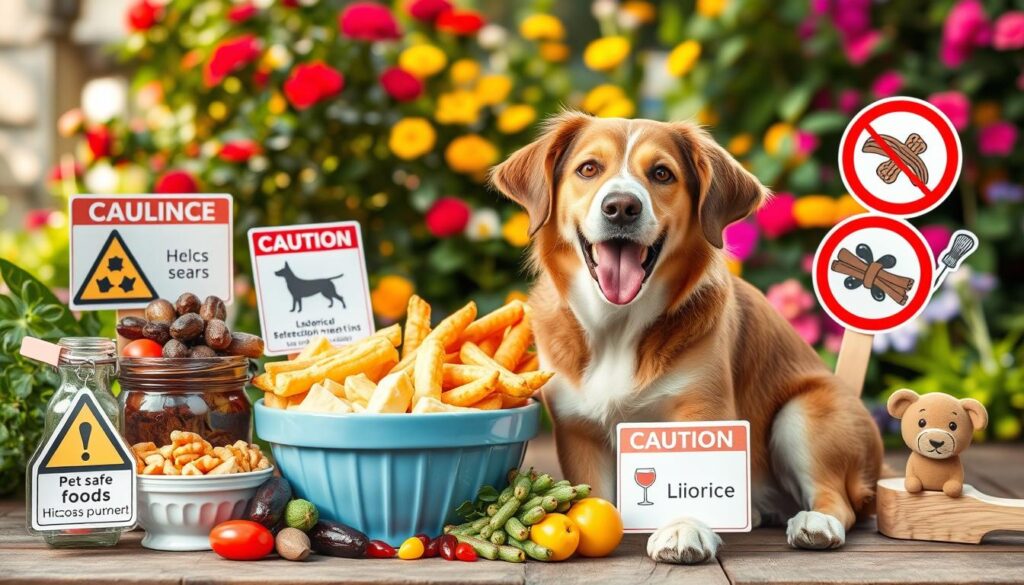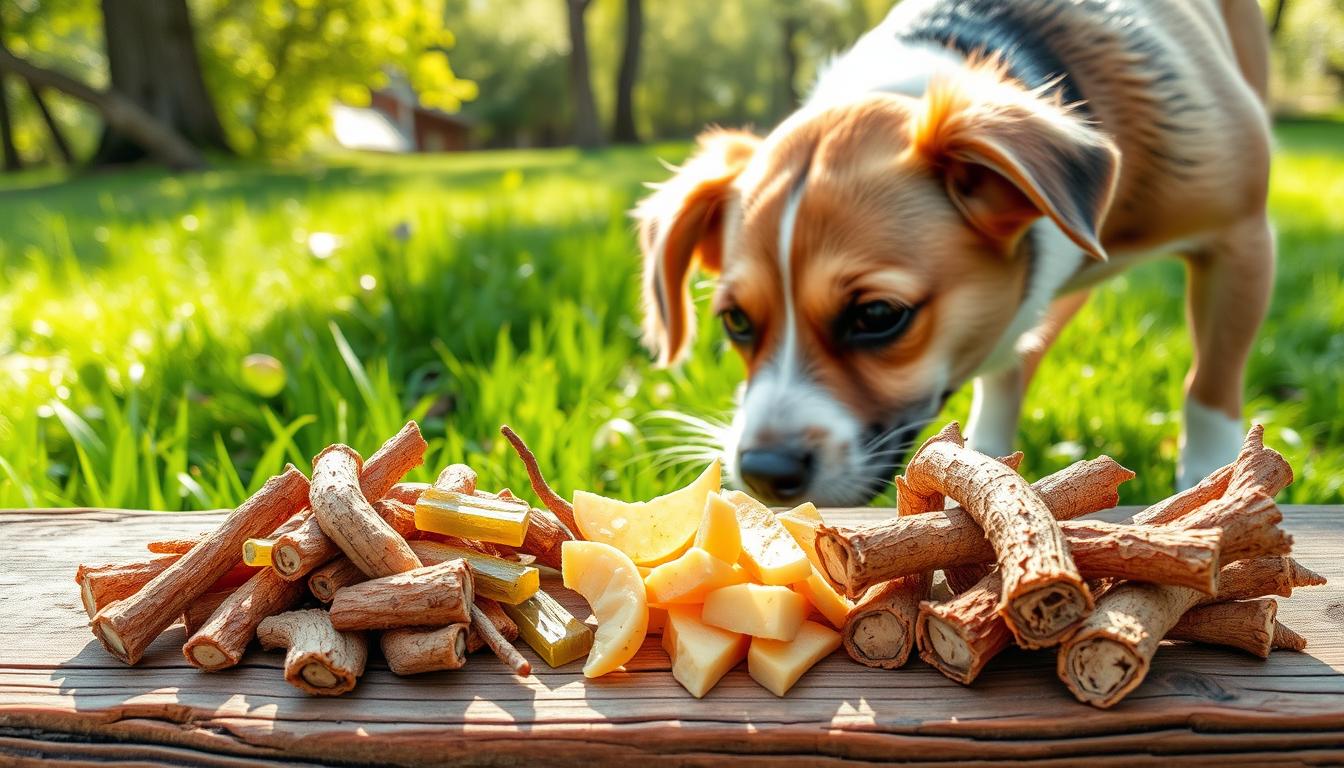As a devoted pet parent, you want the best for your furry friend. You might wonder if dogs can safely enjoy licorice. The truth is, licorice can be risky for dogs if not handled carefully.
In this guide, we’ll explore the dangers of licorice for dogs. We’ll cover the different types of licorice and how to spot toxicity signs. This will help you make safe choices for your dog, whether it’s about treats or just curiosity.
Table of Contents
Understanding Licorice and Its Types
Licorice has a long history and many uses. It’s known for its unique taste, but there are different types. These can be natural or artificial licorice.
Natural vs. Artificial Licorice
Natural licorice comes from the Glycyrrhiza glabra plant. It has a sweet, anise-like taste. Artificial licorice uses synthetic flavors to taste like licorice, without real licorice root.
Common Forms of Licorice Products
- Licorice candies and confections
- Licorice teas and herbal supplements
- Licorice-flavored beverages
- Licorice root extracts and powders
Active Compounds in Licorice Root
Licorice root has compounds that can be good or bad for dogs. These include:
- Glycyrrhizin: This is what makes licorice sweet and flavorful.
- Flavonoids: They might help fight inflammation and infections.
- Coumarins: These can affect how blood clots and interact with medicines.
Knowing the difference between natural and artificial licorice is key. It helps understand the risks of licorice for dogs.
Can Dogs Eat Licorice: Safety and Risks
Licorice might seem safe for dogs, but it’s not without risks. Commercial licorice candies are often too sweet and contain artificial sweeteners. These can harm your dog’s health.
Glycyrrhizin in licorice root can raise blood pressure and upset electrolyte levels in dogs. This is especially true for dogs with heart problems. Also, xylitol, found in sugar-free licorice, can cause low blood sugar and serious health issues in dogs.
Licorice-flavored treats might not have real licorice. Instead, they use artificial flavors. This can upset your dog’s stomach, leading to vomiting, diarrhea, and more.
If your dog eats licorice with harmful substances, see a vet right away. Watch for any changes in behavior or health to keep your dog safe.
Licorice Root Extracts and Health Benefits
Natural licorice root extract might have benefits for dogs, like reducing inflammation and fighting infections. But, always talk to a vet before giving it to your dog. They can help with the right amount and watch for any bad reactions.
Other natural remedies like chamomile, ginger, and turmeric might also help your dog without the risks of licorice.
In short, be careful with licorice for dogs. Use it sparingly, watch them closely, and get vet advice to keep your dog healthy.
Health Effects of Licorice on Dogs
Licorice can have different effects on dogs. Natural licorice root might have some benefits. But, commercial licorice candy can be dangerous. It’s important for pet owners to understand the differences.
Potential Benefits of Natural Licorice Root
Licorice root extract can help dogs in several ways. It has anti-inflammatory and antimicrobial properties. These can help with stomach issues and fight off infections.
Dangers of Commercial Licorice Candy
Commercial licorice candies are risky for dogs. They often have xylitol, which is toxic. It can cause stomach problems, tooth decay, and even be life-threatening.
Impact on Canine Digestive System
Licorice can upset a dog’s stomach. It might cause vomiting, diarrhea, and imbalance of electrolytes. It’s important to be careful with licorice treats or supplements.
Before giving licorice to dogs, especially in strong forms or supplements, talk to a vet. They can help with safety, dosage, and watch for side effects. If licorice is not safe, there are other natural options like chamomile, ginger, and turmeric.
Toxic Ingredients in Commercial Licorice Products
It’s important to watch what you give your dog to eat. Many commercial licorice products have toxic ingredients like xylitol, chocolate, and too much sugar. These can harm your pet’s health.
Xylitol is a sugar substitute found in many foods. It can make a dog’s blood sugar drop fast. This can lead to vomiting, feeling tired, trouble walking, seizures, and liver damage.
Some licorice candies also have caffeine or theobromine from chocolate. These are bad for dogs and can make them agitated, have a fast heart rate, and high blood pressure. These can be very dangerous for your pet.
| Ingredient | Potential Dangers for Dogs |
|---|---|
| Xylitol | Rapid insulin release, dangerous drop in blood sugar levels, vomiting, lethargy, coordination problems, seizures, liver damage |
| Chocolate (Theobromine) | Agitation, high heart rate, elevated blood pressure |
| Excessive Sugar | Weight gain, dental issues, potential digestive problems |
Always check what’s in commercial licorice products before giving them to your dog. Choose natural, safe options to keep your pet healthy and happy.
Signs of Licorice Toxicity in Dogs
It’s important to know the dangers of licorice for your dog. This treat can cause serious symptoms that need vet care fast. Let’s look at the signs of licorice toxicity in dogs and when to call your vet.
Immediate Symptoms to Watch For
If your dog eats licorice, watch for vomiting, diarrhea, lethargy, and loss of appetite. These signs show your dog’s body is trying to get rid of licorice toxins, like glycyrrhizin.
Long-term Health Concerns
Long-term, licorice can harm your dog’s health. They might face liver damage, kidney problems, and heart issues if they keep getting exposed to licorice toxins.
When to Contact Your Veterinarian
If you think your dog ate licorice, especially a lot of it, call your vet right away. Quick vet care can stop serious problems and save your dog’s life.
Always put your dog’s health first. Knowing the signs of licorice toxicity and acting fast can keep your dog safe and happy.
Safe Alternatives to Licorice Treats
Looking for safe treats for your dog? There are many options besides licorice. You can try dog treats made just for them, small pieces of safe fruits and veggies, or dog chews. These can make snack time fun and healthy for your furry friend.
It’s tempting to share human foods with your dog. But, licorice and licorice-flavored items are not safe. Instead, choose safe dog treats that meet your dog’s needs and are easy on their stomach.
You can also give your dog small amounts of licorice alternatives for dogs like carrots, sweet potatoes, or green beans. These natural snacks are safe and can curb their cravings without the risks of licorice.
Always talk to your vet before giving your dog treats. They can help pick the best safe dog treats and how much to give. This keeps your dog happy and healthy.
| Herbal Remedies for Dog Allergies | Dosage Guidelines |
|---|---|
| Nettle Leaf | Use 1/4 teaspoon of dried nettle leaf per 20 pounds of body weight, mixed in food. |
| Rehmannia | Typically, a small pinch of the dried herb for small dogs, and up to 1/4 teaspoon for larger dogs. |
| Licorice Root | Suggested dosage is 1/8 teaspoon of dried licorice root powder per 10 pounds of body weight. |
| Turkey Tail Mushroom | Recommended dose is 1/8 teaspoon of powdered mushroom extract per 10 pounds of body weight. |
| Aloe Vera | Apply a small amount of the gel directly to the affected skin area. |

When introducing new foods or treats, like licorice alternatives for dogs, do it slowly and in small amounts. This helps your dog’s stomach adjust without problems. By focusing on your dog’s health, you can give them tasty and nutritious snacks they’ll enjoy.
Natural Licorice Root as a Supplement
Licorice root might not be the first thing you think of for your dog. But, it can be good for them when used right. It has compounds that help with inflammation, fight off germs, and protect against damage.
Proper Dosage Guidelines
The right amount of licorice root for dogs depends on their size and health. A general rule is 50mg per drop for dogs and cats. For dogs with allergies or acid reflux, more might be needed.
Always talk to your vet before giving your dog any new supplement. They can help make sure it’s safe and right for your pet.
Methods of Administration
There are a few ways to give licorice root to your dog. You can mix a bit of powder into their food. Or, use a tincture and give it to them orally or in their water.
It’s important to follow your vet’s advice on how to give it. Watch your dog for any signs of trouble.
Even though licorice root might be helpful, always check with your vet first. They can guide you on the right amount, how to give it, and watch for any issues.
Prevention and Safety Measures
Keeping dogs safe from licorice is very important. As pet owners, we must act fast to protect our dogs. This is because licorice can be harmful to them.
To stop dogs from eating licorice, keep all candy and human treats out of your dog’s reach. Store licorice products in places your dog can’t get to. Also, teach family and friends not to give dogs human food, especially licorice treats.
Using child-proof locks on cabinets with treats is a good idea. Make sure to throw away candy wrappers and other licorice waste properly. This keeps your dog from getting into them.
By being proactive and creating a safe space for your dog, you can lower the risk of them eating licorice. It’s our duty as pet owners to keep them safe from harmful foods like licorice.

Safe Storage and Handling of Licorice Products
As a responsible pet parent, it’s important to keep licorice products safe from your dog. Licorice is not good for dogs but can be in human treats and supplements. Make sure these are out of your dog’s reach to avoid accidents.
Keeping Treats Out of Reach
Put all licorice items, like candies and supplements, in high places or locked cabinets. This makes your home dog-proof and keeps your dog safe. Also, watch where you leave your snacks or medicine, as dogs might try to eat them.
Emergency Planning for Accidents
Even with precautions, accidents can still happen. Have a plan ready, including your vet’s number and the nearest animal hospital. Keep activated charcoal on hand, as your vet suggests, for accidental ingestion. It can help absorb toxins and prevent more harm. Always watch your dog around human food and treats for their safety.
By following these steps, you can safely store licorice and other harmful products. This way, you’re ready for any unexpected situations. Keeping your dog safe and happy means a life free from licorice.
Conclusion
Dogs should not eat licorice, especially candy. But, a little natural licorice root might be okay with a vet’s help. It’s important to keep harmful treats away and choose safe, vet-approved snacks for your dog.
Always talk to a vet before adding new foods or supplements to your dog’s diet. This ensures their licorice and dogs safety.
Being a responsible pet owner means watching what you give your dog. Natural licorice root might have benefits, but always follow the vet’s advice. This way, you can keep your dog healthy and happy while being a good pet owner.
Your dog’s safety is the most important thing. With the right care and advice from your vet, you can safely use natural licorice root. This will keep your pup happy and healthy.

